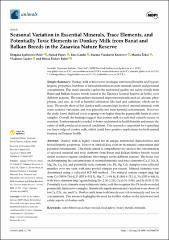| dc.contributor.author | Ljubojević Pelić, Dragana | |
| dc.contributor.author | Popov, Nenad | |
| dc.contributor.author | Gardić, Ema | |
| dc.contributor.author | Vidaković Knežević, Suzana | |
| dc.contributor.author | Žekić, Marina | |
| dc.contributor.author | Gajdov, Vladimir | |
| dc.contributor.author | Živkov-Baloš, Milica | |
| dc.date.accessioned | 2025-03-13T11:36:00Z | |
| dc.date.available | 2025-03-13T11:36:00Z | |
| dc.date.issued | 2025 | |
| dc.identifier.citation | Ljubojevi´c Peli´c, D.; Popov, N.; Gardi´c, E.; Vidakovi´c Kneževi´c, S.; Žeki´c, M.; Gajdov, V.; Živkov Baloš, M. Seasonal Variation in Essential Minerals, Trace Elements, and Potentially Toxic Elements in Donkey Milk from Banat and Balkan Breeds in the Zasavica Nature Reserve. Animals 2025, 15, 791. https://doi.org/ 10.3390/ani15060791 | en_US |
| dc.identifier.issn | 2076-2615 | |
| dc.identifier.uri | https://repo.niv.ns.ac.rs/xmlui/handle/123456789/954 | |
| dc.description.abstract | Donkey milk is highly valued for its unique nutritional characteristics and hypoallergenic properties. However, limited data exist on its mineral composition and potential contaminants. This study aimed to comprehensively analyze the concentration of selected essential and toxic elements from Banat and Balkan donkey breeds reared under extensive organic conditions (free-range) across different seasons. The focus was on determining the concentrations of essential minerals and trace elements (Ca, P, Na, K, Mg, Zn, Cu, Se), and potentially toxic elements (As, Pb, Hg, Cd). Samples were collected monthly over one year, with nine pooled samples per season. Mineral elements were determined using a validated ICP-MS method. The mineral content ranges (mg/kg) were Ca (588.9–744.4), P (355.6–533.3), Mg (71.1–84.4), K (444.4–711.1), Na (355.6–444.4), with trace elements (mg/kg) including Zn (2.06–2.21), Cu (0.31–0.68), and Se (0.02–0.05). Potentially toxic elements were within safe limits, with the exception that Pb levels exceeded permissible limits in two samples. Statistically significant seasonal variations were observed for Ca, P, K, As, and Cu. Donkey milk from both breeds was rich in minerals and low in contaminants. This research highlights the need for further studies on the nutritional and safety aspects of donkey milk. | en_US |
| dc.description.sponsorship | This research was supported by the Science Fund of the Republic of Serbia, grant no. 3535, Project Health Protection and Biodiversity Conservation of Domestic Donkeys in the Special Nature Reserve “Zasavica”—PROTECTDonkey, and by the Ministry of Science, Technological Development and Innovation of Republic of Serbia by the Contract of Implementation and Funding of Research Work of NIV-NS in 2025, Contract No: 451-03-136/2025-03/200031. | en_US |
| dc.language.iso | en | en_US |
| dc.publisher | mdpi | en_US |
| dc.source | Animals | en_US |
| dc.subject | autochthonous donkey breeds | en_US |
| dc.subject | food safety | en_US |
| dc.subject | heavy metals | en_US |
| dc.subject | minerals | en_US |
| dc.title | Seasonal Variation in Essential Minerals, Trace Elements, and Potentially Toxic Elements in Donkey Milk from Banat and Balkan Breeds in the Zasavica Nature Reserve | en_US |
| dc.type | Article | en_US |
| dc.identifier.doi | 10.3390/ani15060791 | |
| dc.citation.volume | 15 | en_US |
| dc.citation.spage | 791 | en_US |
| dc.citation.rank | M21a | en_US |
| dc.type.version | published | en_US |

